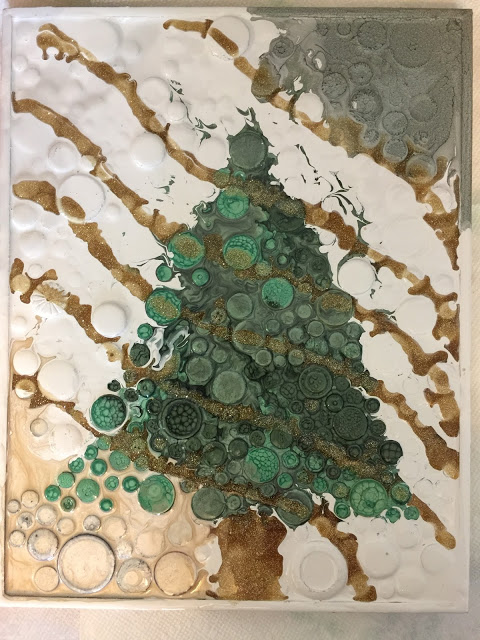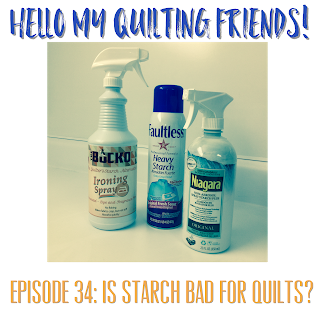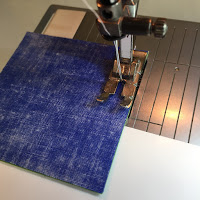Is Starch Bad for Quilts? Podcast Episode #34
You can also watch the podcast and my progress painting over my ruined button mosaic here:
It’s been a wonderful week and I want to start by saying thank you so very much for supporting our new book Explore Walking Foot Quilting with Leah Day. The response has been tremendous and wildly exceeded both Josh and my expectations!
The preorder for this new book will continue until November 30th so right now you can get a great deal on the book which will ship or be emailed to you on December 1st.
Click Here to preorder ebook version.
Click Here to preorder a print version.
During the podcast I was working on my ugly button mosaic and covering it up with Pebeo Prisme, Moon, and Ceramic paints. I love these super thick paints because they create awesome effects all by themselves. Here’s the finished result:

I think this turned out okay! It’s not ending up in the trash, which is something. It’s not exactly what I originally envisioned, but it’s not a terrible result either.
Now I’m turning my attention to finishing up projects before the end of the year and that list is LONG! I have two goddess quilt patterns I’d like to add to the site, lots of new pages to add, and many new videos too.
I spent a good bit of the intro talking about my quilt fiction novel which I’ve been working on every morning. At this point I’m a quarter way through, but experienced a setback when someone wrote in to tell me I was “cheating” at NaNoWriMo by starting my book before November 1st. Color me clueless – I had no idea!
This is the thing: there will always be people that try to derail you, stop you, limit or downright snuff out your light. There are people in this world that hate to see your excitement because they sadly believe that your success means there’s less room for them to succeed too.
I know none of that is true. The more I create, the more I want to create. The more I’ve designed, the more designs that pop freely into my head. And the more people that are teaching, sharing, writing, and designing, the more quilting has a chance reach more people, which means there’s even more space for everyone to succeed.
So no, I’m not participating in NaNoWriMo with this book, but I am still going to write my book! I’ve been using a handy app called Ink On to keep track of my daily word count and progress and Josh has been sticking gold stickers to the kitchen calendar as well.
I like seeing the chain of days – each marked with a bright star to show my progress and to keep me in the habit of writing. I think it’s far more important to sit and write a short bit every day than to write for huge lengths of time one day a week. I feel the same way about quilting. Stitching for 15 – 20 minutes every day will be far more helpful to building your skill than quilting 4 hours every other Saturday.
It’s very exciting to see the chapters coming together and I love the world I’ve created. I want to stitch the quilt from the book and make dolls for the characters. Yes, that’s more projects to make and the list of things I want to finish before 2018 is already pretty long!
 I believe the most important thing is following creativity and giving into the nudge, wherever it’s directing you. Please don’t let the Negative Nellies of this world get in your way or derail your pursuits. It’s so easy to let one negative comment or criticism lock you up, and much harder to trust the overwhelming number of positive voices cheering you on.
I believe the most important thing is following creativity and giving into the nudge, wherever it’s directing you. Please don’t let the Negative Nellies of this world get in your way or derail your pursuits. It’s so easy to let one negative comment or criticism lock you up, and much harder to trust the overwhelming number of positive voices cheering you on.
I’ve also been working on getting out of my own way. Sometimes the only person that’s stopping me from moving forward is ME! I’ve had three awesome embroidery collections basically sitting in files on my computer, waiting for me to get over my stuff and release them. Be looking forward to new projects in that area as well as more embroidery videos too!
As always, I love hearing from you and would love to make even more quilting friends in 2018. If you’d like to be on the podcast or recommend your favorite quilting teacher or company, please send us a message right here.
Now for the Great Quilting Debate! Is Starch Bad for Quilts?
Yes, the choice to use starch on your fabric is a contentious subject in the quilting world and over the years I’ve gotten comments ranging from “You’re ruining people’s quilts with your bad advice!” to “Wow! Starch made such a difference to my fabric and piecing is so much easier now!”

One thing I forgot to include in the podcast is why I use starch – I find it stiffens the fabric nicely, which makes squaring it and cutting pieces and strips much easier and more accurate.
I also find starch fabrics are less likely to fray on the edges. Lately I’ve been testing the stability of my starched fabrics by not pinning units together. Even with the seams pressed open and no pins, my seams are matching every time and I think a lot of that has to do with all the fabrics in the quilt feeling and acting the same. I don’t have one fabric that’s going loosey goosie while another is stiff as a board.
So yes, I’m on Team Starch and I use it to prepare the fabrics in every single quilt we make. If we’re using precuts, every single strip or square is starched on both sides before it’s cut or pieced into the quilt.
A big key to using starch on fabric is knowing the proper technique to use it. The first time I starched a piece of fabric, I sprayed it down, then hit it with my hot iron and suddenly all this horrible flakey white stuff flew everywhere and the bottom of my iron went brown and smelled gross.
It took a few tries before I learned how to apply the liquid to fabric and press without making a massive mess. Learn how I do it in this Quilting Basics video:
As for Team Starch is Evil, I get it! If you’ve been taught that a substance is bad for your fabric and you’ve never used it before and got along just fine, that’s great!
When researching starch, I found a lot of helpful information right here at OldandInteresting.com.
I do think the whole bug-loving-starch thing is a bit silly and I shared my opinion on where that story got started in the podcast. It makes absolutely no sense that a substance used for hundreds of years in clothing that washes out of fabric completely could make a moth more likely to chew up your quilt!
There are a lot more products out there like fusible webs, spray basting, and permanent marking pens that can wreck far more havoc on your quilts and I don’t see a massive concerted effort to demonize them. I’ve written about chemicals in quilts here in case you’re interested in reading further.
As with our last Great Quilting Debate podcast on pressing seams open, I think there’s room for every technique, every method, and every opinion. Please don’t feel like just because you don’t use starch or press your seams open we can’t be friends!
This is a debate so please share your thoughts in the comments below. I’d love to know your thoughts on starching fabric, what you learned when you first started quilting, and how you prepare your fabric now.
If you’re preparing fabric for a quilt this week, make sure to snap a picture and share it with me! If you tag me @LeahDayQuilting on Instagram, I’ll see your photo when you post it!
In 2 weeks I’m going to continue this discussion with another debate on Prewashing! Who would have thought I could turn fabric preparation and piecing into three different podcast episodes?!
Let’s go quilt,
Leah Day


I use starch, and the only thing I see against it is that it remains in whatever fabric you don't use in the quilt (unless you wash it again), and therefore can attract silverfish and the like.
When preparing my fabric for quilting, it is zig-zagged along the two cut edges as soon as it gets home and then put in the washer and dryer with the regular laundry. I rarely use bleach or dryer sheets so this isn't a problem but if these products are going to be used then the fabrics just have to wait for the next load. I have found that clean-finishing the cut edges prevents the tangle of frayed threads and the washing helps straighten the grain and prevent potential bleeding. Once the fabric gets into my sewing room I straighten as you showed but don't fold again and then cut off a 3" strip to sub-cut for my (on-going)charm quilts and "This is the stash" book. The fabric then goes on the shelf for future use.
When cutting for quilts, I haven't ever used starch to stabilize the fabric but am beginning to realize the merits of this, however, I do use a light starch mix to press the blocks and also when webbing the top.
I love your teachings and am learning so many new things here and being reminded of measure twice and cut once, still make the occasional cutting mistake though and sometimes have a very busy seam ripper.
Ok, now I will throw a wrinkle in your debate. What about spray-on fabric stabilizer? It's not starch … and it has been working like a dream for me.
I love the effect of starch on fabric. However, it has stained/discolored a couple of fabrics and I have no idea why 🙁 so no I tend to be wary on whether or not to starch.
Did you wash your fabric before starching? If not, this is excess dye in your fabric that is leaking out and onto itself or other fabrics. If the fabric was white and the starch turned it slightly yellowish, that means you’re scorching the fabric. Use a pressing cloth and lower the temperature of your iron so it doesn’t heat up so fast and burn the lighter fabrics.